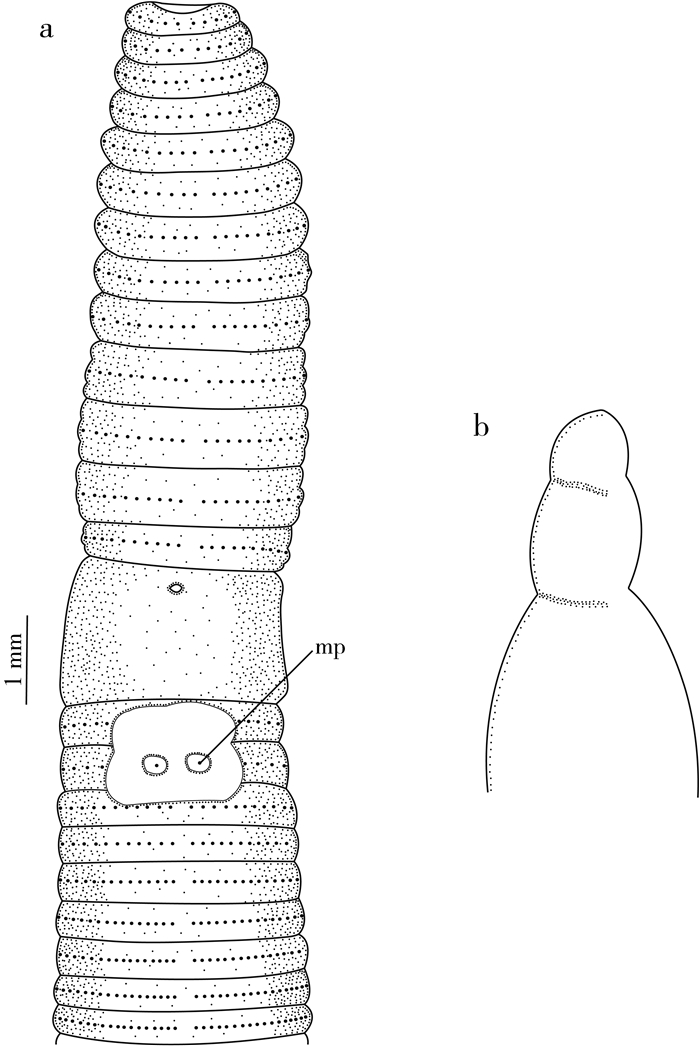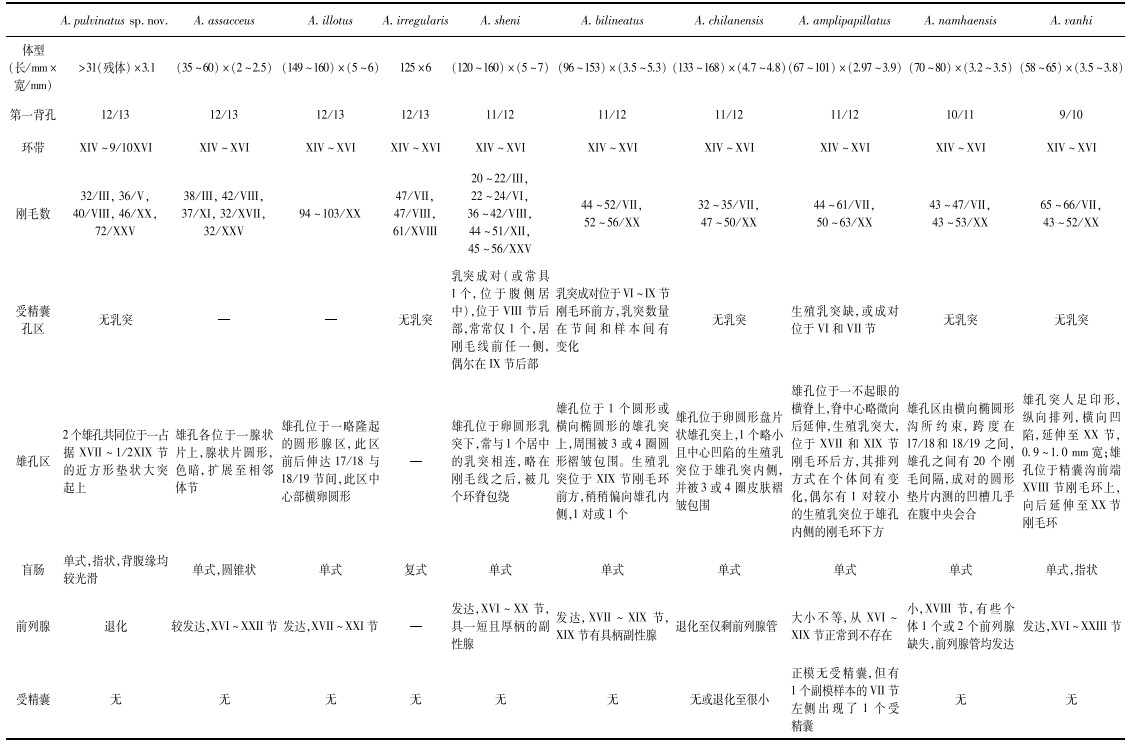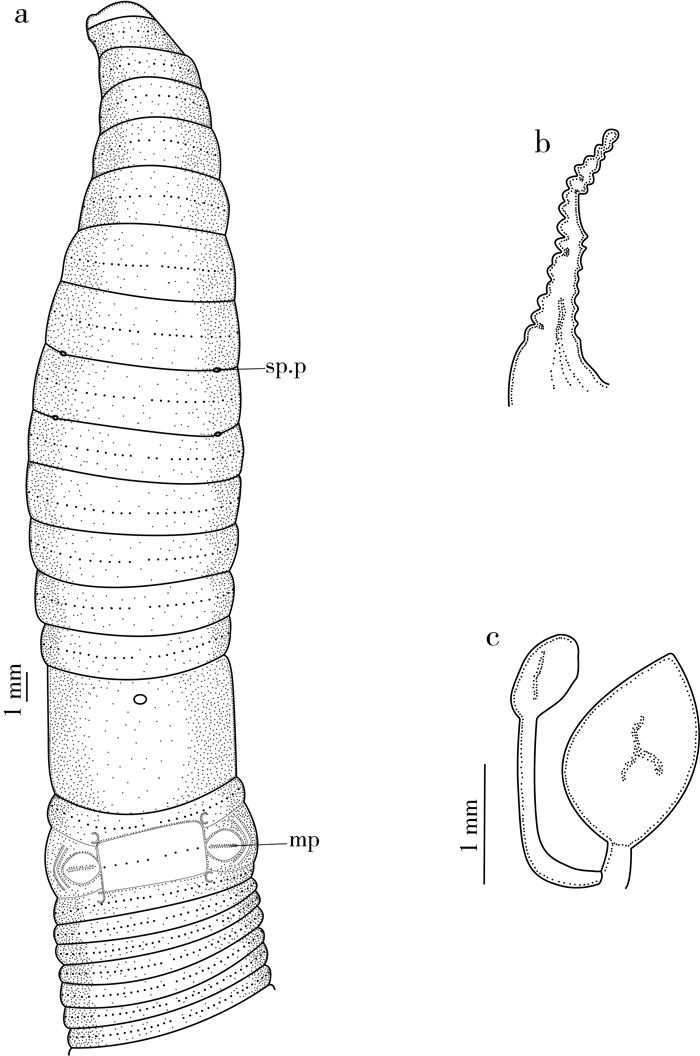扩展功能
文章信息
- 孙静, 蒋际宝, 张林, 邱江平
- SUN Jing, JIANG Jibao, ZHANG Lin, QIU Jiangping
- 3个采集于中国云南的远盲蚓属新物种(单向蚓目:巨蚓科)
- Three New Megascolecidae Species Collected from Yunnan, China (Haplotaxida: Megascolecidae: Amynthas)
- 四川动物, 2021, 40(5): 550-557
- Sichuan Journal of Zoology, 2021, 40(5): 550-557
- 10.11984/j.issn.1000-7083.20210088
-
文章历史
- 收稿日期: 2021-03-12
- 接受日期: 2021-05-19
2. 上海交通大学农业与生物学院, 上海 200240
2. School of Agriculture and Biology, Shanghai Jiao Tong University, Shanghai 200240, China
全世界有蚯蚓6 000余种,其中陆栖蚯蚓有5 000种(Csuzdi,2012)。我国已报道陆栖蚯蚓357种,其中远盲蚓属Amynthas 205种(Xiao,2019)。我国西南部、台湾岛和海南岛是远盲蚓属的热点分布区(Chang et al., 2009;Zhao et al., 2012, 2018;Sun et al., 2015;Yuan et al., 2019)。本研究团队从20世纪80、90年代开始在我国西南部采集蚯蚓,并于21世纪开始在我国南方开展了大范围、系统的蚯蚓采集和报道工作,先后报道了采集于湖北星斗山、广东鼎湖山、广东鹤山、广东象头山、广东黑石顶、海南岛、四川峨眉山、安徽黄山、江西龙虎山、福建梅花山、广西十万大山、广西花坪自然保护区、广西大瑶山、广西九万山、广西猫儿山和贵州雷公山等地的蚯蚓新物种(王海军,邱江平,2005;Zhang et al., 2006;Sun et al., 2009, 2018;Zhao et al., 2013)。本文对从云南西双版纳采集到的3个远盲蚓属新物种进行了报道。
1 材料与方法 1.1 材料采集获得蚯蚓标本21条[标本号:YN201107-12A、YN201107-12B、YN201109-08A、YN201109-08B(1)、YN201109-08B(2)、YN201109-08B(3)、YN201109-08B(4)、YN201109-08B(5)、YN201109-08B(6)、YN201109-08B(7)、YN201109-08B(8)、YN201109-08B(9)、YN201109-08B(10)、YN201109-08B(11)、YN201109-08B(12)、YN201109-08B(13)、YN201109-08B(14)、YN201109-08B(15)、YN201109-05(1)、YN201109-05(2)和YN201107-14]。标本浸渍于95%以上的无水乙醇中,4 ℃保存。所有标本均保存于上海交通大学环境生态工程实验室蚯蚓标本库中。
1.2 形态鉴定使用Nikon SMZ800体视显微镜观察标本,参照陈义(1956)、Sims和Easton(1972)对远盲蚓属蚯蚓特征的表述详细记录外部和内部特征,并绘图。对比中国及周边国家远盲蚓属蚯蚓的物种特征,进行样本鉴定。
2 结果和讨论 2.1 垫区远盲蚓A. pulvinatus Sun & Qiu, sp. nov.(图 1)

|
| 图 1 垫区远盲蚓,正模 Fig. 1 Amynthas pulvinatus Sun & Qiu, sp. nov., holotype a. 腹面,mp. 雄孔;b. 盲肠 a. ventral view, mp. male pores; b. intestinal cecum |
| |
正模:YN201107-12A,1条成体,尾部缺失,于2011年7月20日使用挖掘-手捡法采集于云南省西双版纳傣族自治州勐腊县望天树自然保护区石山脚下红壤中,采样点的主要植物为雏菊Bellis perennis和高乔木,101°34′54″E,21°36′21″N,海拔694 m,属热带季风季雨林雨林气候区。标本采集人:孙静、蒋际宝、冯海玮、雷先德。
副模:YN201107-12B,1条成体,尾部缺失。采集信息同正模标本。标本采集人:孙静、蒋际宝、冯海玮、雷先德。
外部特征:成体体长>31 mm(残体),体宽3.1 mm,体节数>53节。无水乙醇中背侧浅红褐色,腹侧从前往后由浅褐色逐渐变为无色。口前叶1/2上叶式。背孔起于12/13节间。环带位于XIV~ 9/10XVI节。刚毛环生,刚毛数:32/Ⅲ、36/Ⅴ、40/Ⅷ、46/XX、72/XXV。无受精囊孔。雄孔1对,位于XVIII节腹侧两边,各为一圆形腺状突起,两孔腹侧间距约1/8节周长,在一占据XVII~1/2XIX节的近方形垫状大突起上(图 1:a),与常规的"雄孔突各在一垫状突起上",以及该物种群的其他个体有较大区别。雌性生殖孔1个,椭圆形,位于XIV节腹中央。
内部解剖:隔膜8/9~9/10缺,5/6~6/7肌肉质,7/8和10/11~14/15较厚。砂囊桶状,位于Ⅸ~Ⅹ节。背血管向前延续到咽上部。肠自XV节开始膨大。盲肠起于XXVII节,向前延伸至XXV节,单式,较短,指状,背腹缘均较光滑,无缺刻(图 1:b)。食道心脏4对,第1对比其他3对细。精巢囊2对,位于X、XI节,卵圆形,左右叶在腹侧相分离。储精囊2对,位于XI、XII节,较小,左右叶在腹侧相分离。前列腺退化。无受精囊。
DNA条形码:GenBank登录号MW491941(YN201107-12A,正模)。
讨论:蚯蚓多为雌雄同体异体生殖,该新种较特殊,为无雌性生殖器官(受精囊)的孤雌生殖物种,且其雄性生殖附性腺——前列腺也已完全退化。该物种在Sims和Easton(1972)的物种群中属于A. illotus物种群,该物种群的主要特点为无受精囊。
1972年以前,A. illotus-group中的物种有A. ambiguus (Cognetti, 1906)、A. assacceus (Chen, 1938)、A. illotus (Gates, 1932)、A. irregularis (Goto & Hatai, 1899)、A. pusillus (Ohfuchi, 1956)、A. sheni (Chen, 1935)和A. variens (Chen, 1938)。Tsai等(2002)和Blakemore(2007)均认为A. pusillus (Ohfuchi, 1956)和A. assacceus (Chen, 1938)是同物异名。A. variens受精囊除了0对还有1对(5/6节间)或2对(5/6/7节间),严格意义上讲不属于A. illotus物种群(Chen, 1938)。A. ambiguus也因为受精囊数量易变被Easton(1981)从A. illotus物种群转移到了A. hilgendorfi物种群(Blakemore,2007)。因此,1972年以前,A. illotus物种群有4个物种。1972年以后,有5个来自中国台湾和2个来自韩国无受精囊的物种被报道——A. hohuanmontis Tai, Shen & Tsai, 2002、A. bilineatus Tsai & Shen, 2007、A. chilanensis Tsai & Shen, 2007、A. mutabilitas Shen, 2012、A. amplipapillatus Shen, 2012、A. namhaensis Hong and James, 2014和A. vanhi Hong and James, 2014(Tsai et al., 2002, 2007;Shen,2012;Hong et al., 2014)。但A. hohuanmontis和A. mutabilitas是受精囊孔位置易变的物种(Tsai et al., 2002;Chang et al., 2009;Shen,2012)。
至此,A. illotus物种群中共有9个物种。本文所报道的A. pulvinatus Sun & Qiu, sp. nov.是A. illotus物种群中的第10个物种。
从形态上比较了垫区远盲蚓与以上提到的所有物种(表 1)。新物种与以上物种的形态特征均有较大差异。

|
此外,野外采集发现有些蚯蚓物种有为躲避外界干扰主动断尾的行为学特征,该物种正是这种行为学特征的典型代表,因此野外获取的2条样本均无尾部。
在NCBI上进行核苷酸同源性搜索比对,结果显示与垫区远盲蚓DNA条形码相似度最高的5个物种是Metaphire anomala Michaelsen, 1907、A. glabrus (Gates, 1932)、A. corticis (Kinberg, 1867)、A. tontong Panha & Bantaowong, 2011和A. longisiphonus (Qiu, 1988),分别为86.80%、85.26%、85.02%、84.86%和84.74%。DNA条形码差异大于13%,表明新物种与以上物种在分子上为不同物种。
2.2 热带远盲蚓Amynthas tropicus Sun & Jiang, sp. nov.(图 2)

|
| 图 2 热带远盲蚓,正模 Fig. 2 Amynthas tropicus Sun & Jiang, sp. nov., holotype a. 腹面,sp.p. 受精囊孔,mp. 雄孔;b. 盲肠;c. 前列腺;d. 受精囊 a. ventral view, sp.p. spermathecal pores, mp. male pores; b. intestinal cecum; c. prostates gland; d. spermathecae |
| |
正模:YN201109-08A,1条成体,于2011年7月20日使用挖掘-手捡法采集于云南省西双版纳傣族自治州勐纳县曼粉热带雨林原始林红壤中,采样点主要植物为藤本植物和高乔木,101°37′27″E,21°24′14″N,海拔722 m, 属热带季风季雨林雨林气候区。标本采集人:孙静、蒋际宝、冯海玮、雷先德。
副模:YN201109-08B,15条成体,YN201109-05,2条成体,采集时间和地点同正模。标本采集人:孙静、蒋际宝、冯海玮、雷先德。
外部特征:体长141 mm,环带宽4.5 mm,体节数112节。无水乙醇中背部紫红色,腹部无色素,Ⅶ~XIII节每节有2个体环,其他各节无体环。背中线清晰。口前叶前叶和1/2上叶混合式。背孔起于5/6。环带灰褐色,位于XIV~XVI节,指环状,光滑,其上无刚毛和背孔。刚毛环生,AA=1.2AB,ZZ=1.3~1.4ZY。刚毛数:48/Ⅲ,46/Ⅴ,52/Ⅷ,62/XX,56/XXV,受精囊孔间25(Ⅷ),雄孔间12(XVIII)。雄孔1对,位于XVIII节腹侧两边,垫状凸起上,其周围有3~4个白色较矮的圆形乳突,正模的左侧雄孔区刚毛线上方有1个乳突,下方有2个不规则排列的乳突,正模的右侧雄孔区刚毛线上、下方有1个排列规则的乳突,这些乳突的外侧呈腺肿状,雄孔间距略小于1/3节周长。雌性生殖孔1个,位于XIV节腹侧中央。受精囊孔1对,位于7/8,眼状孔,清晰,孔间距约2/5节周长,受精囊孔区无乳突(图 2:a)。
内部解剖:隔膜8/9~9/10缺,5/6~6/7厚,肌肉质,7/8和10/11~14/15较厚。砂囊桶状,位于Ⅸ~Ⅹ节。肠自XV节开始膨大。盲肠单式,起于XXVII节,向前延伸至XXIII节,背缘23/24~25/26隔膜经过处各有1个很小的缺刻,其余部分均光滑,整体指状(图 2:b)。食道心脏4对,位于X~XIII节,均连于食道,在X节心脏前方有1对很细的血管环,在背部连于背血管。精巢囊2对,位于X、XI节,卵圆形,左右叶在腹侧相分离。储精囊2对,位于XI、XII节,非常发达,左右叶在腹侧由一管相连。前列腺较发达,位于XVII~XIX节,块状分叶构成,厚,前列腺管倒"U"形,位于XVIII节,管粗细均匀(图 2:c)。受精囊1对,位于Ⅷ节,主体长3.7 mm,坛囊圆形,长2.9 mm,坛管粗短,盲管长1.9 mm,末端1/2膨大为饱满的卵圆形纳精囊,盲管柄细而直(图 2:d)。
DNA条形码:GenBank登录号KF205472(YN201109-08A,正模)。
讨论:该物种在Sims和Easton(1972)的物种群中属于A. zebrus物种群,该物种群的主要特点为受精囊孔位于7/8节间。
通过与形态相似的物种比较,该新种与分布于四川的物种指掌远盲蚓A. palmosus(Chen,1946) 相似度较高,受精囊孔均为1对,位于7/8,体型大小和体色相近,前列腺均发达。但新种第一背孔位于5/6,刚毛更密集,雄孔周围有乳突,受精囊孔区无乳突,盲肠单式,纳精囊相对较短(占盲管的1/2),且受精囊区无附性腺,而A. palmosus第一背孔位于12/13,刚毛较稀,雄孔区无乳突,受精囊孔区有时有大乳突,盲肠复式,纳精囊更长(占盲管的2/3),且受精囊区有附性腺。
在NCBI上进行核苷酸同源性搜索比对,结果显示与热带远盲蚓DNA条形码相似度最高的5个物种是A. phatubensis Panha & Bantaowong, 2011、M. tecta (Chen, 1946)、M. posthuma (Vaillant, 1868)、A. gracilis (Kinberg, 1867)和A. moniliatus moniliatus (Chen, 1946),分别为83.48%、82.42%、82.40%、81.90%和81.90%。DNA条形码差异大于16%,表明新物种与以上物种在分子上为不同物种。
2.3 裂缝远盲蚓Amynthas hiatus Sun & Qiu, sp. nov.(图 3)

|
| 图 3 裂缝远盲蚓,正模 Fig. 3 Amynthas hiatus Sun & Qiu, sp. nov., holotype a.腹面:sp.p. 受精囊孔,mp. 雄孔;b. 盲肠;c. 受精囊 a.ventral view: sp.p. spermathecal pores, mp. male pores; b. intestinal cecum; c. spermathecae |
| |
正模:YN201107-14,1条成体,于2011年7月20日使用挖掘-手捡法采集于云南省西双版纳勐纳县望天树自然保护区石山脚下红壤中,采样点主要植物为雏菊和高乔木,101°34′54″E,21°36′21″N,海拔694 m,属热带季风季雨林雨林气候区。标本采集人:孙静、蒋际宝、雷先德、冯海玮。
外部特征:体长156 mm,环带宽5.5 mm,体节数130节。无水乙醇中背部紫褐色,腹部无色素,周身无体环,背中线较清晰。口前叶1/3上叶式。背孔起于12/13。环带浅灰色,位于XIV~XVI节,指环状,隆起,其上无刚毛和背孔。刚毛环生,AA=AB,ZZ=1.8ZY。刚毛数:26/Ⅲ,34/Ⅴ,44/Ⅷ,64/XX,66/XXV,雄孔间9(XVIII)。雄孔1对,位于XVIII节腹侧两边,为1个较大的椭圆形腺区,中间1条横缝,椭圆形外侧有4圈呈锐角的皮肤褶皱,雄孔间距约1/3节周长,雄孔上、下方偏内侧位置,XVII节刚毛环下方和XIX节刚毛环上方各有1个凹陷的乳突,乳突深陷于一腔内形成"C"字形,"C"字开口向外侧,乳突间距略大于1/4节周长,4个乳突和2个雄孔所包围的矩形区域为一大片颜色略深的腺肿区。雌性生殖孔1个,位于XIV节腹侧中央,椭圆形。受精囊孔2对,位于7/8~8/9,孔小,不易察觉(图 3:a)。
内部解剖:隔膜8/9~9/10缺,5/6~6/7厚,肌肉质,7/8和10/11~13/14较厚。砂囊桶状,位于Ⅸ~Ⅹ节。肠自XIII节开始逐渐膨大,XV~ XVIII节初步膨大,但相对较细,XIX节开始再次膨大。盲肠起于XXVII节,向前延伸至XX节,介于单式和复式之间,背腹缘均为1排较浅的指状小囊,整体呈现长指状(图 3:b)。食道心脏4对,位于X~XIII节,第1对细长,连于背血管,后3对发达,连于食道上血管。精巢囊2对,发达,卵圆形,位于X、XI节,左右叶在腹侧相分离。储精囊2对,位于XI、XII节,发达,大小相同,左右叶在腹侧相分离。前列腺中等发达,位于XVI~XIX节,外侧指状分叶,内部块状分叶,厚,前列腺管"U"形,位于XVIII节,腹侧管比背侧管略粗。受精囊2对,位于Ⅷ~Ⅸ节,第2对比第1对发达,第1对长1.9 mm,第2对长2.2 mm,坛囊呈饱满的心形,坛管粗短,约为坛囊的2/5长,盲管与主体等长,盲管柄粗,前端1/3膨大为饱满的卵圆形纳精囊(图 3:c)。
DNA条形码:GenBank登录号KF205460(YN201107-14,正模)。
讨论:该物种在Sims和Easton (1972)的物种群中属于A. aeruginosus物种群,该物种群的主要特点为受精囊孔位于7/8/9节间。
该种与分布于中国和越南的广布种A. triastriatus (Chen,1946)颇为相似,都属于体型中等偏大的蚯蚓,均有2对受精囊孔,位于7/8~8/9节间,受精囊坛囊心形,盲管前端膨大的纳精囊(Sims & Easton,1972;Blakemore,2007)。但新种第一背孔位于12/13,刚毛粗细均匀,身体后部刚毛更密集,雄孔区乳突形状复杂,盲肠背腹缘均具缺刻,受精囊盲管与主体等长,前列腺中等发达,而A. triastriatus第一背孔位于10/11,前8节刚毛较长,身体前后刚毛疏密均匀,雄孔区乳突形状较为简单,盲肠背腹缘均光滑,受精囊盲管较主体长,前列腺缺失(Chen,1946)。
在NCBI上进行核苷酸同源性搜索比对,结果显示与裂缝远盲蚓DNA条形码相似度最高的5个物种是A. taiwumontis Shen, Chang, Li, Chih & Chen, 2013、A. yambaruensis (Ishizuka & Azama, 2000)、A. amis Shen, 2012、A. tuberculatus (Gates, 1935)和A. phucheefah Bantaowong & Panha, 2014, 分别为84.80%、84.62%、84.35%、83.66%和83.64%。DNA条形码差异大于15%,表明新物种与以上物种在分子上为不同物种。
致谢: 感谢上海交通大学冯海玮和雷先德在样本采集工作中提供的帮助。
陈义. 1956. 中国蚯蚓[M]. 北京: 科学出版社.
|
王海军, 邱江平. 2005. 星斗山自然保护区环毛类蚯蚓初步调查——附远盲属两新种及一新亚种描述[J]. 上海交通大学学报(农业科学版), 23(1): 23-30. DOI:10.3969/j.issn.1671-9964.2005.01.006 |
Blakemore RJ. 2007. Updated checklist of pheretimoids (Oligochaeta: Megascolecidae: Pheretima auct. ) taxa[EB/OL]. (2007-12-01)[2020-12-07]. http://www.annelida.net/earthworm/Pheretimoids.pdf.
|
Chang CH, Shen HP, Chen JH. 2009. Earthworm fauna of Taiwan[M]. Taipei: National Taiwan University Press.
|
Chen Y. 1938. Oligochaeta from Hainan, Kwangtung[J]. Contributions from the Biological Laboratory of the Science Society of China (Zoological Series), 12(10): 375-427. |
Chen Y. 1946. On the terrestrial Oligochaeta from Szechuan, iii[J]. West China Border Research Society Series B, 16: 83-141. |
Csuzdi C. 2012. Earthworm species, a searchable database[J]. Opuscula Zoologica Instituti Zoosystematici Et Oecologici Universitatis Budapestinensis, 43(1): 97-99. |
Hong Y, James SW, Inkhavilay K. 2014. Three new earthworms of the genus Amynthas (Clitellata: Megascolecidae) from Nam Ha NPA, Laos[J]. Animal Systematics Evolution and Diversity, 30(2): 81-86. DOI:10.5635/ASED.2014.30.2.081 |
Shen HP. 2012. Three new earthworms of the genus Amynthas (Megascolecidae: Oligochaeta) from eastern Taiwan with redescription of Amynthas hongyehensis Tsai and Shen, 2010[J]. Journal of Natural History, 46(37-38): 2259-2283. DOI:10.1080/00222933.2012.716867 |
Sims RW, Easton EG. 1972. A numerical revision of the earthworm genus Pheretima auct. (Megascolecidae: Oligochaeta) with the recognition of new genera and an appendix on the earthworms collected by the Royal Society North Borneo Expedition[J]. Biological Journal of the Linnean Society, 4(3): 169-268. DOI:10.1111/j.1095-8312.1972.tb00694.x |
Sun J, Jiang J, Bartlam S, et al. 2018. Four new Amynthas and Metaphire earthworm species from nine provinces in southern China[J]. Zootaxa, 4496(1): 287-301. DOI:10.11646/zootaxa.4496.1.24 |
Sun J, Jiang J, Zhao Q, et al. 2015. New earthworms of the Amynthas morrisi-group (Oligochaeta, Megascolecidae) from Hainan Island, China[J]. Zootaxa, 4058(2): 257-266. DOI:10.11646/zootaxa.4058.2.7 |
Sun J, Zhao Q, Qiu J. 2009. Four new species of earthworms belonging to the genus Amynthas (Oligochaeta: Megascolecidae) from Diaoluo Mountain, Hainan Island, China[J]. Revue Suisse De Zoologie, 116(2): 289-301. |
Tsai CF, Shen HP, Tsai SC. 2002. A new athecate earthworm of the genus Amynthas Kinberg (Megascolecidae: Oligochaeta) from Taiwan with discussion on phylogeny and biogeography of the A. illotus species-group[J]. Journal of Natural History, 36(7): 757-765. DOI:10.1080/00222930010026391 |
Tsai CF, Shen HP, Tsai SC, et al. 2007. Four new species of terrestrial earthworms belonging to the genus Amynthas (Megascolecidae: Oligochaeta) from Taiwan with discussion on speculative synonyms and species delimitation in oligochaete taxonomy[J]. Journal of Natural History, 41(5-8): 357-379. DOI:10.1080/00222930701201279 |
Xiao N. 2019. Terrestrial earthworms (Oligochaeta: Opisthopora) of China[M]. Beijing: Elsevier Science.
|
Yuan Z, Jiang J, Dong Y, et al. 2019. The dispersal and diversification of earthworms (Annelida: Oligochaeta) related to paleogeographical events in the Hengduan Mountains[J/OL]. European Journal of Soil Biology, 94: 103118[2021-01-20]. https://doi.org/10.1016/j.ejsobi.2019.103118.
|
Zhang WX, Li JX, Fu SL, et al. 2006. Four new earthworm species belonging to Amynthas Kinberg and Metaphire Sims et Easton (Megascolecidae: Oligochaeta) from Guangdong, China[J]. Annales Zoologici, 56(2): 249-254. |
Zhao Q, Cluzeau D, Briard C, et al. 2012. Hainan earthworm community and the comparison with other East and Southeast Asia countries for geographic distribution and endemic rate (Oligochaeta)[J]. Zoology in the Middle East, 58(sup4): 141-149. DOI:10.1080/09397140.2012.10648996 |
Zhao Q, Jiang J, Sun J, et al. 2013. Four new earthworm species and subspecies belonging to genus Amynthas and Metaphire (Oligochaeta: Megascolecidae) from Hainan Island, China[J]. Zootaxa, 3619(3): 383-393. DOI:10.11646/zootaxa.3619.3.7 |
Zhao Q, Yao X, Lan Y, et al. 2018. New earthworm species of the genus Amynthas from Hainan Island, China (Megascolecidae, Clitellata)[J]. Zootaxa, 4496(1): 279-286. DOI:10.11646/zootaxa.4496.1.23 |
 2021, Vol. 40
2021, Vol. 40




